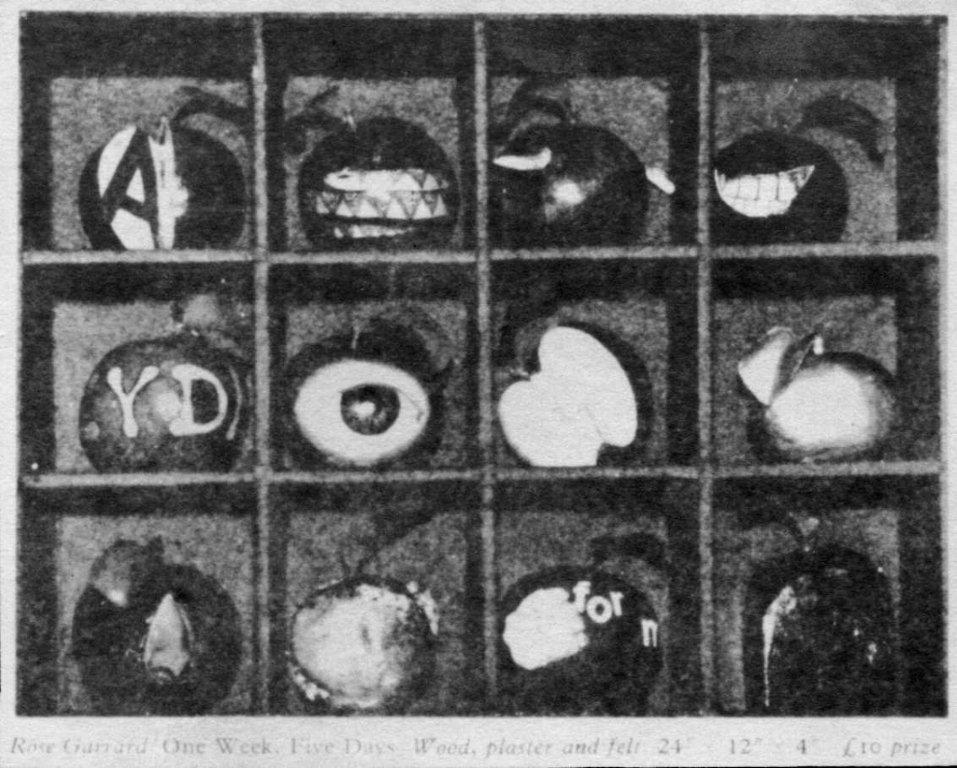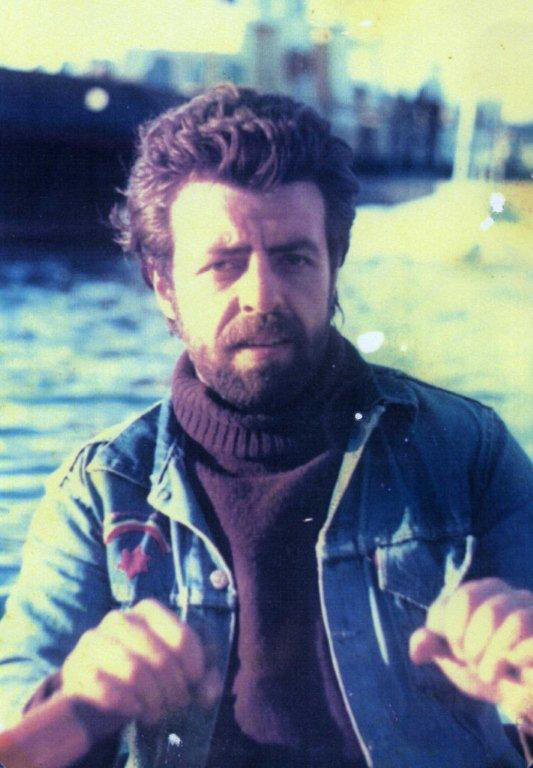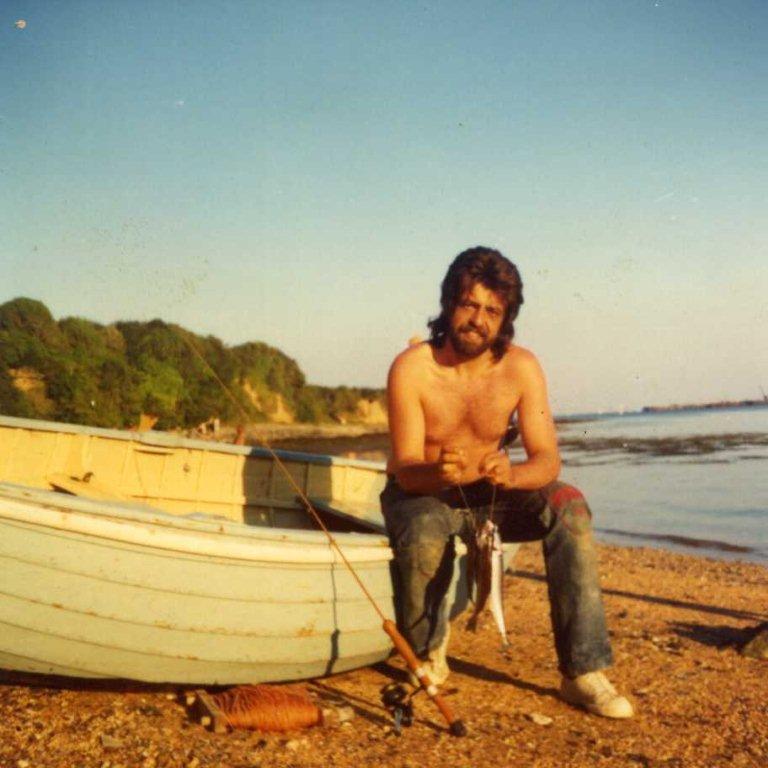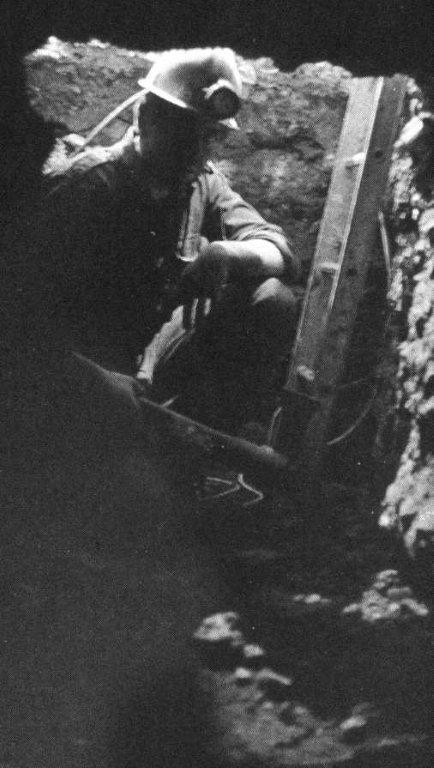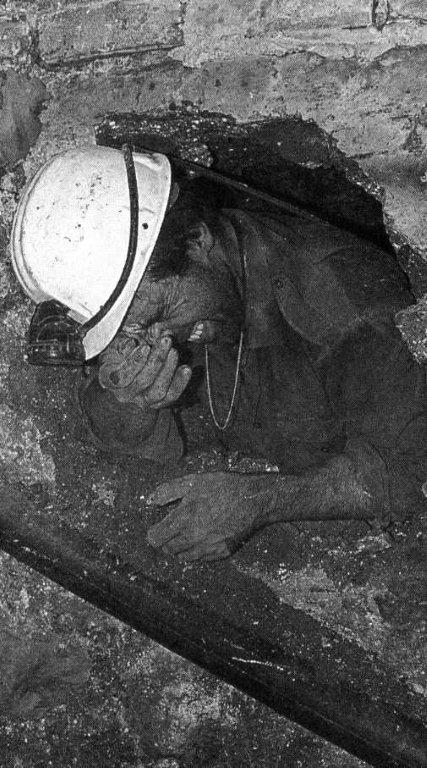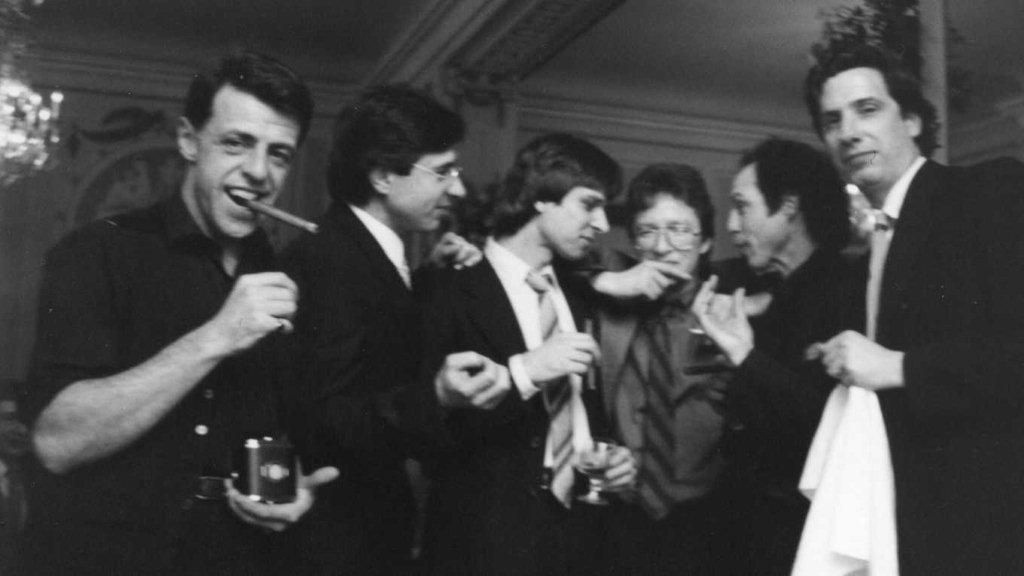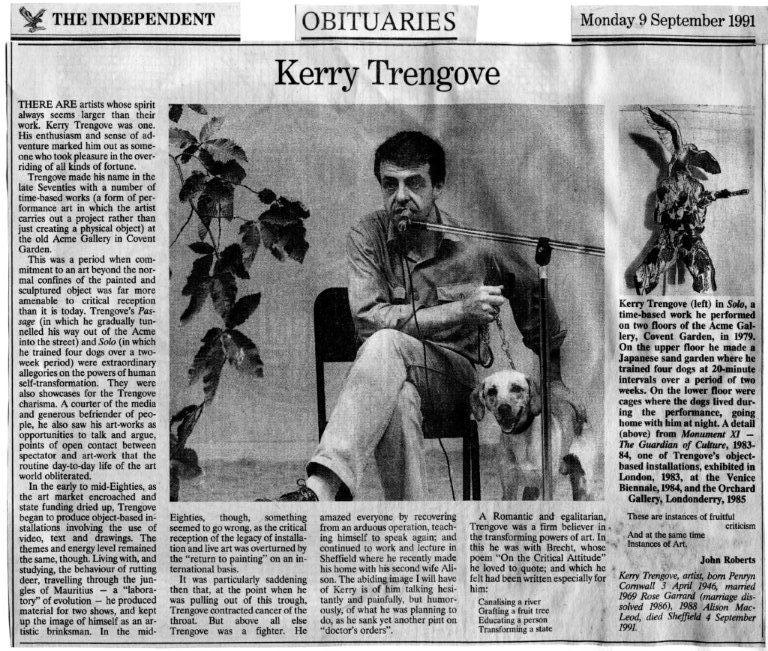|
|
| home | features | exhibitions | interviews | profiles | webprojects | gazetteer | links | archive | forum |
|
Kerry Marshall Trengove: a memoir Kerry Trengove made his name as an artist during the 70's with durational artworks and installations including more than one at the influential Acme Gallery in Covent Garden. In 1984 he exhibited as part of the Venice Biennale. In this very personal account artist and wife, Rose Garrard, recalls the years they spent together.
Rose and Kerry in Worcestershire, 1960's
When I first met Kerry he was secretly on 3 years probation for criminal damage, apparently with 27 other cases taken into account, for using a diamond ring to drunkenly engrave designs on many of the large shop windows along Falmouth High Street. He had been thrown out of the painting department there, but the sculpture tutor Ray Exworth, took him in, making him work late into the evenings under strict conditions of no wine or women.
Kerry’s final show Birmingham College of Art 1968
Once at Birmingham he was still made to attend extra studies as part of his probation; Sociology at Aston University and Contemporary Art at Colemore Row, which he lapped up. When we began dating in his second year he was drinking ten or more pints a night while deadening his ulcerated gullet with whisky and milk. The head of sculpture at Birmingham, John Bridgeman, had long despaired of making Kerry conform to the course and warned me against him. In his final year Kerry worked hard and drank far less, but decided to tease 'Bridge' by apparently working continually on making one box, actually a series of identical boxes for his final minimalist installation. When eventually Bridge tried to force him to have a tutorial, Kerry got drunk in the studio, driving him away by violently throwing bottles of beer at the door. When Bridge insisted to the External Examiners that Kerry should not be awarded a 1st but a 2/1 Degree, Kerry was furious and wouldn’t accept that this was largely due to his bad behaviour, not his work. As a consequence he couldn’t get onto a Fine Art Post Graduate course and in 1968 began Teacher Training at Goldsmiths instead. For fourteen years we loved each others company and rarely spent time apart, enjoying teaching, lecturing, exhibiting, becoming ‘roadies’ on each others’ exhibitions and just having fun together. He was my most trusted friend; gregarious and rebellious, a fascinating and caring companion and a delightful lover.
‘One Week Five Days’, Valentine gift of 12 plaster apples from Rose to Kerry in 1968. Multiples prize from Paolozzi 1969
After I graduated in the summer of 1969, we were house-sitting in north London for Derek Southall, one of our college painting tutors, when we decided to get married, but without telling our families. A few days later the Southalls returned from holiday and we told them our plans, asking them to be our witnesses. Derek brought his family and his camera along and took professional-looking photos, which when sent to our parents upset them even more as it looked very pre-planned. We all returned to our newly found flat for drinks and sandwiches to celebrate, leaving us with seven shillings and six pence to begin married life.
Marriage of Kerry and Rose at Wood Green Register Office, with the painter and friend Derek Southall, his wife and family as witnesses, 1969
Before our first visit each summer Poppa would rescue the Valkyrie from the sail loft and staunch the 12ft clinker built boat by sinking it to swell her timbers. Our first job when we arrived each season was to clean her bottom, caulk any leaks, repaint her and service the outboard motor. Then we were free to go, with a packed lunch of Momma’s huge pasties or doorstep crab sandwiches and beer, - idyllic! As well as beach-combing and sun-bathing, we often went line-fishing for mackerel. Usually the catch was taken proudly home for supper, but once it was slapped on the bar of the old fisherman’s pub on the quayside where there were peals of laughter when Kerry shouted “Take the drinks out of these!” Kerry had lost most of his Cornish accent while at College and the famously grumpy landlord here had previously insulted Kerry by refusing to serve a ‘geeker’, an English day tripper.
Kerry rowing across Falmouth harbour, 1970's.
Momma and Poppa, Florence and Jan Trengove, were warm, light hearted, fun and openly loving towards each other, and to Kerry and I. Noisy rows were quite frequent, but always ended with huge hugs before bedtime. They ran a tiny pub, ‘The Masons’ Arms’ on the Moor in Falmouth. Momma was a great cook and a very large lady weighing over twenty stone with a personality to match. If there was any physical trouble at closing time, rather than calling on ‘Janner’, evictions were dealt with by Flo who relied on her sheer size and womanliness to protect her, knowing that if all else failed the regulars would leap in. Poppa had been a merchant seaman for 22 years and had survived being sunk three times during the war, although he wouldn’t talk about this. He was small in stature but was very respected in the community, and said to have settled docks’ disputes by ‘knocking both sides heads together’ in after hours ‘lock-ins’ until agreement was reached. In his younger days he was occasionally called on to dowse for water, and now when neighbours died, to lay them out before rigamortis set in. His birth certificate had been ‘lost’ during the war, so the St Austell Brewery couldn’t make him retire until he was ready, at well past 70.
Kerry, the Valkyrie and fish catch 1973
Few people realised that we were actually married as we had agreed not to reveal this ‘convention’ in the art world and I was still known professionally by my maiden name. But Kerry had always firmly believed that he would die young. Self-destructive and a heavy drinker, by his thirties he fell into cycles of deep depression followed by periods of elation, each lasting several months (bipolar disorder?). When I was offered my first regular part-time lecturing post at Reading University in 1976, to raise Kerry’s spirits I persuaded them to invite him to ‘job-share’ with me. We proved a great team, much liked by the students, and he was an inspiring, if dominating, teacher. An idealist, nothing now seemed to satisfy Kerry, particularly during his darkest times, and I quietly devoted much of my time to finding him shows and to helping him organise his art ideas in more practical ways. I would often stop my own studio work to help him fulfil his exhibition commitments, but this never seemed enough. Struggling to pay for his brilliant, ambitious, but increasingly expensive artistic projects, I became the main earner, making advertising and TV props, lecturing as well as exhibiting my own work. While my workload increased, he spent more and more time out drinking with other artists and critics. He often behaved dangerously, saying he liked living on the edge. One night he walked home through London down the white line in the middle of the road, defiantly drunk. He seemed to look to me to curb his worst excesses, but over the years this became an increasingly impossible and unwelcome burden.
Kerry relaxing in the park at Hammersmith 1974
Safety was never a priority with Kerry. When planning his best known and most dangerous one-person show 'Passage', this became a major issue. He wanted to undertake tunnelling underground beneath the gallery foundations, but he intended to tunnel out under the building without any precautions. He was to be sealed in a concrete cell measuring 10ft x 15ft, built on the ground floor of the Acme Gallery, Covent Garden, in October 1977, with continuous artificial light inside, surviving on a supply of piped fresh air and a restricted diet. We worked out the logistics of storing the essentials for life; sufficient water and powdered vitamins as sustenance (Complan), plus a bunk and a portaloo. A close circuit video and a two way sound system linked with the upper gallery was also essential, to enable visitors to talk with him at any time. To tunnel out he needed an electric Kangol hammer and hand tools, a pulley system and sufficient timber to shore-up the tunnel, all to be housed in the smallest possible cell, which eventually was to also contain all the displaced earth. I did persuade Kerry to wear a miners’ hard hat and a special air-bag belt that I had managed to get the Coal Board to lend me in case of a cave-in. But once sealed in the cell Kerry refused to use any of the timber to support the tunnel, so I remained fearfully on watch in the Gallery whenever he was awake. Throughout Kerry’s ten days of tunnelling, a very angry District Surveyor from the Council arrived each morning to try to close the exhibition down, at first arguing vehemently with the gallery director Jonathan Harvey and myself, but soon Henry Lydiate of Art Law came on board and every morning protected the work from the injunctions that were served until Kerry emerged. The only sound in the lower Gallery was a harrowing sound-track of political detainees’ experiences from interviews made by Kerry, through contacts with Amnesty International. I had to do the editing to create the finished tape as Kerry found it too upsetting to listen to again. As well as massive press coverage of the show, including most of the tabloids, excerpts from the detainees’ stories were broadcast daily by the World Service to the countries involved in their torture - amazing.
But immediately after he emerged, although exhausted from working on his hands and knees for so long, Kerry accepted the challenge to play squash with Jonathan, tearing the ligaments in his knee and ending up in hospital for an emergency operation. Having persuaded friends to smuggle in bottles of whisky to the ward, he was soon thrown out for drunkenness and bad behaviour. But it soon became evident that the physical isolation, plus the success of this show seemed to have changed him, now leaving him seeking constant praise and attention. Having attracted huge positive publicity during the show, Kerry had begun to greatly enjoy the attention and adulation of a small group of young female fans that had grown up around him in the pub. 'Put me in the path of temptation' became his favourite phrase. He began to frequently stay out all night, his return marked with strange guilty gifts, such as an obviously stolen bunch of someone’s garden flowers or a lawnmower, and on one occasion a white mouse, that were all intended to make me laugh. Naively I continued to trust his stories of drunken stop-overs with our male friends, who often backed his claims.
Kerry on left with cigar, hip-flask and friends
But by the eighties I suspected he was having secretive affairs with our younger colleagues and students at colleges where we both were teaching; the classic stereotype of the male art tutor. These affairs had always been denied by Kerry, but were now often cruelly flaunted in public, with girls appearing in his favourite pullovers at exhibitions and bouquets of flowers flamboyantly presented to them in front of me during private views. I sometimes confronted both his lovers and him, but with only temporary effect.
Kerry and I had shared more than a decade of married joy together; filled with a cascade of thoughts and ideas, a continual energised ‘conversation’ about art, religion, philosophy, ourselves and the universe, before our relationship began to deteriorate. Even after a final year of measured drunkenness and absence except when sometimes returning home to bed, Kerry still refused to leave me, eventually saying I should move next door and then we could be like Simone De Beauvoir and Jean Paul Sartre, each having lovers.
Returning home from lecturing, one evening I found a pair of someone else’s briefs in my knicker drawer, so I packed a bag and left him in December 1982, preferring to sleep in my freezing studio. Apparently when we were invited to events throughout this early period of separation, rather than admit the truth, Kerry told everyone I was ill and couldn’t come. I still hoped he would get over his mid-life crisis and we would grow old together. I felt like an amputee without him and had to keep remembering the worst of times to stay away. But after four years apart nothing had improved and in 1987 I reluctantly agreed to a simple divorce. I hoped this would make him happy, but wanted nothing else from him now.
Kerry Trengove obituary in The Independent 1991
Our divorce was finalised in February 1989. After this Kerry became very ill with throat cancer, but I only learned of this from a friend later that year. I phoned him, but he seemed in worryingly high spirits, laughing and joking about it. What he didn’t tell me was that he was in a party, having just married one of our young students that day, a twenty three year old blond from Sheffield Hallam University. The following year we arranged to meet and spent a tearful afternoon together in a park in Bow. By then Kerry had undergone a major operation to remove half his neck and tongue and looked terribly thin and ill. He was still breathing through a tracheotomy but had now learnt to speak again and said he had never stopped loving me and that I had kept him alive. A year later I was invited to be at his bedside in Sheffield with his sister Janice and his new wife Alison, and after several nights there he died aged 45 on 4th September 1991, which, unknown to Alison, would have been our 22nd wedding anniversary.
Self destructive to the end, Kerry had left instructions for Alison to burn all his work and to scatter his own ashes in the sea from ‘Black Rock’, in Falmouth Bay, his favourite dangerous place. Having taken the risk of clambering out there in a gale on the 21st September, Alison was apparently covered in his cinders when they blew back inland. But it seems these were only half his ashes; against his strongest instructions the other half were kept by his mother and buried in her arms when she died just a few years later.
TrenGOVE is an ancient Cornish name "By Tre, Pol and Pen, shall ye know the names of Cornishmen". The GOVE part (not the English gRove) is Cornish for blacksmith. From at least the 16th century at Merry Meeting on the Falmouth to Redruth Road, in the parish of Gwennap, there was an early smithy owned for many years by a family called Trengove, possibly ancestors… © Rose Garrard September 2010 |
|
|




